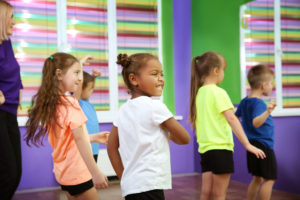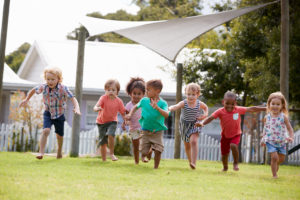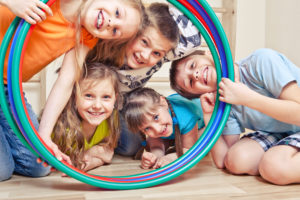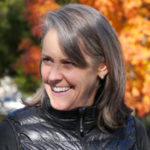In 2000, I had 5 years of experience leading group exercise classes for adults and two rambunctious children at home. I realized that every time I took my kids to the playground and let them loose, I liked them better. For the balance of the day, they were happier, more even-keeled, and definitely more reasonable. I thought to myself, “I get adults moving, How hard can it be to get kids moving? And if I do it during the school day, I can give them back to their teachers who would surely like them better, too.”
And Pop, Hop, and Rock™ was born.
At the time, I was blissfully unaware of the real repercussions of what I was doing. I started my business working with schools, getting kids playing aerobic games that recruited as many muscles as possible. We had lots of sweaty fun, and I sent happy kids back to their preschool teachers. Soon, however, I realized that we weren’t just having active fun. We were feeding a real need in children to move – not just to get their wiggles out, but to do the essential work of childhood.

Children need “big body” play to develop in all aspects – physically, mentally, emotionally, and academically. Their growing brains need their growing bodies to move to build essential neural pathways. With that realization and a lot of research, Pop, Hop, and Rock™ went from just a business to a passion. And Pivot to Play™ became a way to share that passion with other fitness professionals.
At Pop, Hop & Rock™ and Pivot to Play™, our goal is to get kids moving. We have found that the best way to leverage what we do is by taking our programming directly to the kids where they are, which is in schools and child care centers.
Every year since 2000, I have grown my Pop, Hop and Rock™ business, adding schools and coaches in an effort to get more kids moving. Every year, we have added curriculum and lesson plans to support the specific strengths and skills we have identified as deficient in more and more kids. Every year, we share our play programming with thousands of kids. And every year, we train hundreds of teachers and administrators on the critical importance of big body play.
Sadly, it hasn’t changed the fact that children today are more sedentary and weaker than they have ever been. Veteran teachers report there are more behavior challenges with their students than they have ever seen, and this connection is no coincidence. The significant decline in physical activity in our children is leading directly to adverse outcomes in the classroom.
At Pop, Hop & Rock™ and Pivot to Play™, our mission is to change the way our culture values physical activity, looking through the lens of big body play. We know kids are more likely to participate in something that is fun, so we deliver proven, replicated games that are fun. But hidden in all the fun is essential skill development. When we get kids moving in exciting high-energy games, we help them build confidence in their own physicality, giving them confidence on the playground, playing field, classroom, and life.
If you are ready to start your own program getting kids moving, we have found there are three effective ways to launch big body play programming in schools: 1. Targeting the right schools, 2. Perfect pricing, 3. Creating and effective marketing hook.
1. Targeting the right schools
 Private schools are the easiest to access and the best place to start building a business. As much as I would love to work with students in public schools, the system works against small businesses. “Breaking in” means jumping through hoops and dealing with mounds of red tape. It doesn’t mean that the nut can’t be cracked, but it could take an entire school year or more to get a program up and running. Instead, private schools tend to have a more open-door policy with vendors, fewer rules and red tape, and more flexibility in general.
Private schools are the easiest to access and the best place to start building a business. As much as I would love to work with students in public schools, the system works against small businesses. “Breaking in” means jumping through hoops and dealing with mounds of red tape. It doesn’t mean that the nut can’t be cracked, but it could take an entire school year or more to get a program up and running. Instead, private schools tend to have a more open-door policy with vendors, fewer rules and red tape, and more flexibility in general.
Within the world of private schools, the best place to start is with private preschools and child care centers. Large franchised child care centers can be challenging to land as clients because they have more formalized processes that take longer to navigate. Church-based preschools, independent Montessori-style programs, and independent child care centers are far more open to vendors.
Bonus Tip: Once you have decided on your target schools, consider the age of the children you would be working with. If you are just starting your business and need to build your own confidence working with kids, the sweet spot to teach big body play programming is 3-5 years old (especially older 3-year-olds to younger 4-year-olds).
Children at this age are the most enthusiastic about playing, eager to test their bodies and skills, less concerned about competition with peers, and more likely to understand multi-step directions. All of this adds up to serious fun for both you and the kids. (One caveat – no two groups of children are alike. So you might find a particular group of 2-year-olds to be perfectly delightful and another set of 4-year-olds to be challenging. Such is the nature of working with children.)
2. Perfect pricing
Of course there isn’t a program out there that is as good as yours, but there are other programs out there: soccer, dance, art, music, gymnastics, cheer, etc. Find out what they are charging and make sure your fee is in line with theirs. School budgets are very tight and once you price yourself out of the market, it is easy to lose clients and very difficult to win them back.

We started our program by charging the same hourly rate as a fitness instructor would be paid by a gym. In other words, we underpriced our product for the first year. Then we slowly raised our prices every year, giving schools plenty of warning so they could plan for us in their budget.
As we added new clients, we charged them the most current rate. It took us several years to get to the price point we wanted, but it was worth the wait. We have never lost a client because of cost. Instead, each year our value becomes more and more evident to our clients, helping us leverage our expertise to gain new clients.
Bonus Tip: Small private and independent schools network with each other. They may seem like competitors, but they look to each other for leads and advice. Most of our marketing is through word of mouth from one school to the next. So proving your value with one school will likely gain you another school and client.
3. The marketing hook
Now that you have found your potential clients and have set the perfect price, you just have to sell your program. And that can be difficult in the crowded marketplace of vendors competing for limited school resources. How can you differentiate your program from all the other vendors promising programs that are fun or active or educational? Simple – your program will be all three.

We’ve had success with what we call our Key Skills and Strengths System. We evaluate every activity we use with children to determine its developmental heft by seeing how many of the Key Skills and Strengths it builds. Take a simple game of Triangle Tag where tagged kids hold triangle pose until a friend crawls through the triangle made by their legs.
Sure, kids are getting aerobic, working on balance, and building strength – the active part is obvious. But, they are also working on a host of other essential skills and strengths including:
- body, directional, spatial, and temporal awareness
- the proprioceptive system
- the vestibular system
- motor planning
All of these skills are foundational to academic success, making the game educational. And, best of all, the kids are having a blast, laughing and shouting with their friends. So much fun! This is reflected in our conversations, marketing materials, and other interactions we have with teachers and school administration.
The Bottom Line: In 20 years of working with kids in school, we have seen some real magic take place when they get moving. One of the most fulfilling aspects of this work occurs when you hear the sounds the children make when they are with us. We hear loud voices, joyful talking, full-belly laughing, singing, and happy shouting with friends. On top of that, we see big, sweaty smiles.
Children’s bodies are built to move. When we respect the need for children to move, we feed their bodies and brains so they can find success in the classroom, on the playground, and in the future.
For more information about Pop, Hop & Rock™ and Pivot to Play™, go to https://pophopandrock.com/pivot-to-play-certification/.






Connect with SPIDERfit!